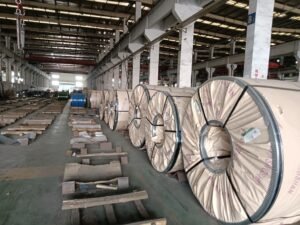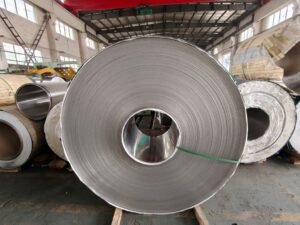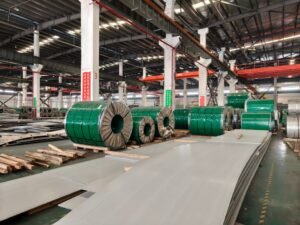Introduction
Choosing the wrong steel grade can derail your project—compromising safety, hiking costs, or causing delays. Construction professionals and engineers face the challenge of matching steel grades to specific demands like strength, corrosion resistance, and fabrication ease.
That’s where steel grade selection becomes a no-brainer with the right guidance. This guide breaks down key factors, from ASTM A36 for general use to A588 for harsh environments, helping you pick the perfect structural steel for durability and efficiency.
Understanding Steel Grades and Their Importance
Steel grades play a big role in construction projects. They determine how strong, durable, and safe a structure will be. This guide to choosing the right steel grade explains why steel grade selection matters and how it impacts project success.
What Are Steel Grades? Definition and Classification
Steel grades are labels that show the properties of steel, like strength and resistance to corrosion. They’re classified based on chemical makeup and how they’re processed. For example, types of structural steel like carbon steel or alloy steel have different uses in construction.
Each grade follows standards like ASTM, EN, or JIS, which set rules for quality. These standards make it easier to pick the right steel for specific jobs. Knowing these classifications helps builders avoid costly mistakes.
“Proper steel grade selection ensures structures are safe, long-lasting, and cost-effective, saving time and money in the long run.”
Why Steel Grade Selection Matters for Structural Integrity
Choosing the right steel grade keeps buildings and bridges standing strong. A weak grade might crack under pressure, risking safety. Steel grades for construction, like high-strength low-alloy steel, are designed to handle heavy loads.
Wrong choices can lead to repairs or even disasters. For instance, a bridge needs steel that resists weather and weight. Suppliers like HnL Steel offer expert advice to match grades to project needs, ensuring safety and compliance.
Overview of Common Standards (ASTM, EN, JIS)
Global standards guide steel grade quality. ASTM, used in the U.S., sets benchmarks for strength and durability. EN standards, common in Europe, focus on consistency across countries, while JIS, from Japan, ensures precision for industrial use.
These standards help builders compare steel grades worldwide. Working with a supplier like HnL Steel ensures the steel meets these rules, reducing risks. Their team provides technical support to navigate complex standards.
Impact of Steel Grades on Project Success
Steel grades affect more than just safety—they impact budgets and timelines. High-quality grades, though pricier, last longer and need less maintenance. This makes them a win-win for cost-conscious projects.
Real-world examples show their value. For instance, using high-strength steel in skyscrapers cuts material costs while boosting durability. HnL Steel’s range, from Galvalume coils to I-Beams, offers options for any project, with fast delivery to keep schedules on track.
Steel Grade Performance Comparison
| Steel Grade | Tensile Strength (MPa) | Corrosion Resistance | Cost per Ton (USD) | Common Use |
|---|---|---|---|---|
| ASTM A36 | 400-550 | Low | 600 | Buildings |
| ASTM A572 | 450-620 | Moderate | 750 | Bridges |
| EN S355 | 470-630 | Moderate | 800 | Offshore Platforms |
| JIS G3101 SS400 | 400-510 | Low | 580 | General Structures |
| High-Strength Low-Alloy | 550-700 | High | 900 | Heavy Machinery |
Note: Tensile strength measures how much force steel can handle (MPa = megapascals). Corrosion resistance shows how well it withstands rust. Costs are approximate, based on 2024 global averages. Data aligns with ASTM, EN, and JIS standards.

Key Factors for Selecting the Right Steel Grade
Choosing the right steel grade is critical for any construction project. Steel grade selection affects strength, durability, and how easily the material can be worked with. This guide explores what is the best steel grade for structural applications, helping you make informed choices.
Strength Properties: Matching Grades to Load Requirements
Steel grades vary in strength, measured by tensile and yield strength. High-strength grades, like ASTM A572, handle heavy loads in bridges or skyscrapers. Knowing how to select steel grades ensures your project meets safety and performance needs without overspending.
For lighter structures, a grade like ASTM A36 may suffice. HnL Steel offers tailored solutions, such as pre-processed beams, to match specific load demands. Their expertise helps you pick grades that balance strength and cost.
“Steel grade selection optimizes structural performance by matching material strength to project demands, ensuring safety and efficiency.”
Corrosion Resistance: Choosing Weathering Steel for Harsh Environments
Corrosion resistance is key in harsh climates. Weathering steel, like Corten, forms a protective rust layer, boosting the durability of steel grades. It’s ideal for outdoor structures like bridges or coastal buildings.
Standard grades, like JIS G3101 SS400, may need coatings to resist rust. HnL Steel provides Galvalume coils with high corrosion resistance, saving maintenance costs. Their team advises on grades suited for specific environments.
Fabrication Ease: Balancing Strength with Weldability and Machinability
Strong steel grades can be tough to weld or cut. Grades like EN S355 offer a sweet spot—strong yet easy to fabricate. This balance speeds up construction and reduces labor costs.
High-strength low-alloy steels are harder to machine but durable. HnL Steel’s pre-processed pipes and beams simplify fabrication, ensuring compliance with standards like ASTM or JIS. Their solutions streamline projects without sacrificing quality.
Environmental and Regulatory Considerations
Steel production impacts the environment, so sustainable choices matter. Some grades, like those with recycled content, lower carbon footprints. Regulations, like ASTM or EN standards, also dictate grade choices for safety and compliance.
Choosing the right grade avoids legal issues and supports eco-friendly goals. HnL Steel’s technical consultants ensure your steel meets global standards, offering flexible delivery to keep projects on track. Their diverse range, from I-Beams to stainless steel, fits any regulatory need.
Steel Grade Suitability Comparison
| Steel Grade | Tensile Strength (MPa) | Corrosion Resistance | Weldability | Regulatory Compliance |
|---|---|---|---|---|
| ASTM A36 | 400-550 | Low | Excellent | ASTM Certified |
| ASTM A588 (Corten) | 485-620 | High | Good | ASTM Certified |
| EN S355 | 470-630 | Moderate | Excellent | EN Certified |
| JIS G3101 SS400 | 400-510 | Low | Good | JIS Certified |
| High-Strength Low-Alloy | 550-700 | Moderate | Moderate | ASTM/EN Certified |
Note: Tensile strength (MPa) indicates load capacity. Corrosion resistance reflects environmental durability. Weldability shows fabrication ease. Compliance ensures adherence to ASTM, EN, or JIS standards, based on 2023 industry data.
Types of Structural Steel Grades and Their Applications
Understanding steel grade selection is key to successful construction projects. Different steel grades for construction have unique strengths and uses, making them suited for specific jobs. This guide highlights the differences between steel grades in construction and their real-world applications.
ASTM A36: Versatile Choice for General Construction
ASTM A36 is a go-to for general construction due to its affordability and versatility. It’s used in buildings, warehouses, and small bridges, offering decent strength at 400-550 MPa. HnL Steel’s A36 beams are a no-brainer for cost-effective projects.
Its weldability makes it easy to work with, though it’s less resistant to corrosion. For small-scale projects, A36’s balance of strength and price is hard to beat. HnL Steel ensures fast delivery of A36 products to keep timelines tight.
“Steel grade selection matches material properties to project needs, ensuring durability and cost-efficiency in construction.”
A572 and A514: High-Strength Options for Heavy Loads
ASTM A572 and A514 are high-strength grades for demanding structures like cranes or heavy-duty bridges. A572 offers 450-620 MPa, while A514 can hit 690-760 MPa, perfect for extreme loads. These grades shine in projects needing robust application of steel grades.
Fabrication can be tricky due to their strength, but HnL Steel provides pre-processed beams to simplify the process. Their expertise ensures compliance with ASTM standards, supporting heavy-load applications.
A588: Weathering Steel for Corrosion Resistance
ASTM A588, or Corten, is a weathering steel that resists corrosion without coatings. Its rust-like patina protects structures like sculptures or coastal bridges, lasting decades in harsh environments. This makes A588 ideal for low-maintenance projects.
HnL Steel’s A588 products, like customized plates, enhance durability in tough climates. Their Galvalume options complement A588 for corrosion-heavy applications, offering clients versatile solutions.
S355 and A992: Industry Standards for Bridges and Skyscrapers
EN S355 and ASTM A992 are staples for large-scale projects like skyscrapers and major bridges. S355 (470-630 MPa) is a European favorite for its weldability, while A992 (345-450 MPa) is a U.S. standard for high-rise frames. Both excel in structural stability.
HnL Steel’s I-Beams in these grades meet global standards, ensuring safety and precision. Their technical support helps clients navigate steel grades for construction, optimizing project outcomes.
Structural Steel Grade Applications
| Steel Grade | Tensile Strength (MPa) | Corrosion Resistance | Primary Application | Standard Compliance |
|---|---|---|---|---|
| ASTM A36 | 400-550 | Low | Warehouses | ASTM |
| ASTM A572 | 450-620 | Moderate | Bridges | ASTM |
| ASTM A514 | 690-760 | Low | Cranes | ASTM |
| ASTM A588 | 485-620 | High | Coastal Structures | ASTM |
| EN S355 | 470-630 | Moderate | Skyscrapers | EN |
Note: Tensile strength (MPa) measures load capacity. Corrosion resistance indicates environmental durability. Applications reflect common uses based on 2023 industry trends. Compliance ensures adherence to ASTM or EN standards.
Balancing Cost and Performance in Steel Grade Selection
Making smart choices in steel grade selection can save money and ensure a project’s success. This guide to choosing the right steel grade explores how to balance upfront costs with long-term performance. By understanding how to select steel grades, you can optimize budgets without compromising quality.
Cost Drivers: Material Price vs. Fabrication Complexity
Steel grades vary in price based on their steel properties, like strength or corrosion resistance. For example, ASTM A36 is cheaper but requires more fabrication effort, raising labor costs. Higher grades, like A572, cost more upfront but simplify construction due to their strength.
Complex fabrication can eat into budgets. HnL Steel’s pre-processed beams reduce these costs, offering a win-win for efficiency. Their team helps you pick grades that align with your budget and project needs.
“Steel grade selection balances initial costs with fabrication and long-term durability, ensuring cost-effective and safe structures.”
Long-Term Savings: Durability and Maintenance Benefits
Investing in durable steel grades cuts maintenance costs over time. Weathering steel, like ASTM A588, resists corrosion, reducing the need for repairs in harsh environments. This durability makes it ideal for bridges or coastal projects.
Cheaper grades may need frequent upkeep, raising expenses. HnL Steel’s Galvalume coils enhance durability, saving money in the long run. Their fast delivery ensures these high-performance grades reach your site on time.
Case Studies: Cost-Effective Steel Grade Choices in Real Projects
Real projects show the value of smart steel grade selection. A Midwest warehouse used ASTM A36 for its low cost, saving 15% on materials while meeting safety standards. In contrast, a coastal bridge chose A588, cutting maintenance costs by 20% over a decade.
These examples highlight practical applications. HnL Steel’s customized I-Beams and pipes supported both projects, meeting ASTM and EN standards. Their expertise ensures you pick grades that deliver results.
Procurement Strategies: Bulk Buying and Supplier Partnerships
Bulk buying lowers costs for large projects. Partnering with suppliers like HnL Steel offers flexible payment terms, making bulk procurement easier. Their diverse range, from stainless steel to T-sections, supports varied project needs.
Strong supplier relationships ensure consistent quality and timely delivery. HnL Steel’s focus on long-term partnerships provides technical support and competitive pricing. This approach maximizes savings while maintaining structural integrity.
Cost vs. Performance Comparison of Steel Grades
| Steel Grade | Cost per Ton (USD) | Tensile Strength (MPa) | Maintenance Cost | Typical Application |
|---|---|---|---|---|
| ASTM A36 | 600 | 400-550 | High | Warehouses |
| ASTM A572 | 750 | 450-620 | Moderate | Bridges |
| ASTM A588 | 850 | 485-620 | Low | Coastal Structures |
| EN S355 | 800 | 470-630 | Moderate | Skyscrapers |
| A992 | 780 | 345-450 | Moderate | High-Rises |
Note: Costs are 2023 global averages. Tensile strength (MPa) shows load capacity. Maintenance cost reflects long-term upkeep needs. Applications are based on industry trends.
Best Practices for Procurement and Compliance
Effective steel grade selection ensures projects meet safety, durability, and regulatory standards. This guide offers practical strategies for procuring types of structural steel while staying compliant with global standards. By following these steps, you can streamline procurement and boost project efficiency.
Verifying Compliance with ASTM, EN, and JIS Standards
Global standards like ASTM, EN, and JIS ensure steel meets quality and safety requirements. For example, ASTM A36 must pass tensile strength tests, while EN S355 adheres to European structural codes. Verifying compliance avoids costly rejections or safety issues.
Check supplier certifications before purchasing. HnL Steel provides compliance documentation for their products, ensuring durability of steel grades. Their expertise helps you navigate complex standards like JIS for Asian markets.
“Steel grade selection with verified compliance guarantees safe, durable structures while meeting global regulatory demands.”
Partnering with Reliable Suppliers for Quality Assurance
Trustworthy suppliers are key to securing high-quality steel. Look for those with a track record of meeting ASTM or EN standards, like HnL Steel, which offers a “rock-solid” quality assurance process. Their range includes I-Beams and Galvalume coils tailored for structural needs.
Suppliers should provide test reports and material traceability. HnL Steel’s industry experience ensures consistent quality, supporting projects from bridges to skyscrapers. Partnering with them reduces risks of defective materials.
Streamlining Supply Chain Logistics for Timely Delivery
Delays in steel delivery can derail project timelines. Efficient logistics, like tailored transport plans, ensure timely arrivals. HnL Steel’s fast delivery and flexible payment terms help keep projects on schedule, especially for large-scale builds.
Bulk procurement minimizes delays and cuts costs. Understanding what is the best steel grade for structural applications streamlines orders. HnL Steel’s global reach ensures reliable logistics for international projects.
Leveraging Supplier Expertise for Custom Processing
Suppliers with technical expertise can provide custom solutions, like pre-cut beams or specialized pipes. This saves time and ensures precision for complex projects. HnL Steel’s team offers tailored processing, aligning with specific project needs.
Custom solutions also enhance compliance and efficiency. For example, pre-processed S355 beams meet EN standards and reduce on-site work. HnL Steel’s consultancy services guide you through types of structural steel for optimal results.
Steel Grade Procurement Comparison
| Steel Grade | Compliance Standard | Delivery Time (Days) | Custom Processing | Quality Assurance |
|---|---|---|---|---|
| ASTM A36 | ASTM | 7-10 | Available | Certified |
| ASTM A588 | ASTM | 10-14 | Available | Certified |
| EN S355 | EN | 8-12 | Available | Certified |
| JIS G3101 SS400 | JIS | 7-10 | Limited | Certified |
| A992 | ASTM | 9-13 | Available | Certified |
Note: Delivery times are 2023 industry averages. Custom processing indicates pre-cut or specialized options. Quality assurance reflects supplier certifications, aligned with ASTM, EN, or JIS standards.

Conclusion
After a decade in the steel industry, I’ve seen how picking the right steel grade can make or break a project. It’s not just about meeting specs—it’s about ensuring your structure stands strong, saves money, and lasts for decades.
From ASTM A36 for budget-friendly builds to A588 for weathering tough climates, the right choice balances strength, durability, and cost. Partnering with a supplier like HnL Steel, with their focus on quality and fast delivery, simplifies the process and keeps your project on track.
Choosing the perfect steel grade isn’t just a technical decision—it’s a game-changer for your project’s success. Take the time to match your needs with the right grade, and you’ll build something that endures.
FAQ
Q1: What is the best steel grade for structural applications?
A1: The best steel grade for structural applications typically depends on factors such as the required strength, weldability, and environmental conditions. Common choices include S235, S355, and S690, with S355 being popular for its high strength and toughness.
Q2: How do I select the right steel grade for my project?
A2: To select the right steel grade, consider the mechanical requirements, environmental exposure (e.g., corrosion), and fabrication processes involved in your project. Consulting existing guidelines and standards can provide valuable insight.
Q3: What are different types of steel grades used in construction?
A3: Common types of steel grades used in construction include carbon steels (e.g., S235 and S355), stainless steels (e.g., 304 and 316), and alloy steels which provide enhanced properties like strength and corrosion resistance.
Q4: How does corrosion resistance impact steel grade selection?
A4: Corrosion resistance is crucial in environments exposed to moisture and chemicals. Stainless steel grades, such as 316, offer high resistance, while carbon steels may require protective coatings to improve durability.
Q5: What factors should be considered when choosing a steel grade?
A5: Key factors include the load-bearing requirements, environmental factors (like exposure to moisture), welding compatibility, and cost constraints. Balancing strength and ductility is essential for structural integrity.
Q6: Can multiple steel grades be used in one project?
A6: Yes, it’s common to use multiple steel grades in a project based on different applications or components. Each grade can offer specific benefits tailored to the needs of that part of the structure.
Q7: What is the format for steel grade designation?
A7: Steel grades are typically denoted using a letter followed by a number, such as ‘S355’ or ‘A36’. The letter indicates the type of steel, while the number reflects the yield strength or specific properties.
Q8: What is the role of sub-grades in steel selection?
A8: Sub-grades provide additional specifications for steel performance, often relating to impact resistance at specific temperatures. For instance, S355 J0 applies tests to ensure ductility at lower temperatures.
External Links
- Steel Selection – American Galvanizers Association
- Selecting the Correct Steel Grade – RIDBA
- Steel Grades: 10 Most Common Types & Their Uses
- Understanding Steel Grades: What Do They Mean?
- Material selection and product specification – Steel Construction
- The Best Guide to Selecting the Right Steel – Mentored Engineer
- How to select the best grade of steel for the application
- IS 2062 Steel: Material Grades, Chemical Composition, Applications






2 Responses